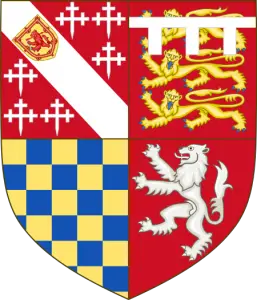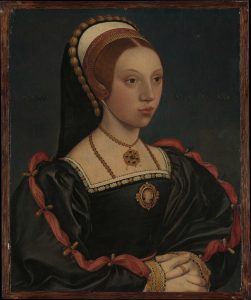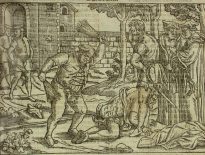
Arms of Thomas Howard, 2nd Duke of Norfolk, Edmund's father
Lord Edmund Howard was born in around 1478 as the third son of Thomas Howard, 2nd Duke of Norfolk, and his first wife, Elizabeth Tilney, Countess of Surrey. Edmund came from a successful family; his father having served under four monarchs. During the tumultuous Wars of the Roses period, Edmund’s father supported the Yorkists, serving both Edward IV and Richard III. Thomas Howard was awarded the Earldom of Surrey in 1483, alongside being appointed to the Privy Council and becoming an invested member of the exclusive Order of the Garter. Upon Richard III’s defeat at the Battle of Bosworth in 1485, the Earl of Surrey was imprisoned for a period and stripped of his honours as a result of his treasonous actions against the newly established Tudor throne. The now King Henry VII was discerning in his prevention of Surrey’s execution; intent on proving himself a merciful monarch in the wake of decades of factional brutality. Henry was later reassured that Surrey was a loyal servant and restored his earldom in May 1489. Similarly, the earl regained his position in society, taking up the role of Lieutenant of the North until 1499. From this point onwards, Surrey became a valued, trusted and loyal man to the Tudor crown; with his forces decimating the Scottish forces at Flodden in 1513. A year later, he was granted the title of Duke of Norfolk, one of England’s preeminent titles; which came with significant lands and annuities. When the duke died in 1524, his funeral was attended by a significant number of exclusive guests who congregated at Framingham Castle to pay their respects to a hugely influential figure at the Henrician court.
Edmund came from an illustrious family. He grew up being familiar with court life, having been a page boy during his younger years, and became a primary member of the king’s men, affectionately known as the ‘fresh young gallants’; who took part in King Henry VIII’s coronation celebrations. As Gareth Russell states in his biography of Howard’s daughter, Catherine Howard, Edmund would have been an athletic young man, able to participate in the king’s celebratory jousts. The coronation was a hugely elaborate, symbolic and joyous occasion; encompassing miniature castles for jousting and fairy-tale inspired arenas to entertain the multitude of guests. Tudor roses and pomegranates (Katherine of Aragon’s insignia; an ancient, Christian symbol of fertility) lined the miniature castle, entwining the two in matrimony while discreetly promoting Katherine’s fertility. Lord Edmund performed well at the coronation events and was invited to participate in the celebrations succeeding the birth of the king’s son, Henry, Duke of Cornwall, in 1511. This time, however, Edmund was asked to lead the defenders in the joust; clearly a demonstration of his prowess in the previous celebrations of 1509. The Tudor crown spared no expenses in the entertainments: the miniature, man-made configurations were garnished with jewels, golden damask, green velvet and precious silks. Henry had artificial rocks and imported ferns to mark the occasion; no luxury was too ostentatious to commemorate the birth of a future Tudor king. Lord Edmund was such a skilled jouster that it was recorded he sent the nineteen-year-old king to the ground on several occasions when paired against him.
While Howard was manifesting himself as the pinnacle of chivalric manhood during the social events of the Henrician calendar, he did not continue to rise in the king’s favour. While other courtiers who performed at celebratory events, such as Charles Brandon (who became one of the king’s closest confidants), became close friends with the king, Edmund did not receive a similar honour; nor was he invited to join the wars against France during the earlier half of the 1510s. However, he was involved, alongside his brother Thomas (the future 3rd Duke of Norfolk), in the Battle of Flodden as Marshal of the Horse on 9th September 1513. During this period, while the king was on campaign in France, Edmund demonstrated his courage and loyalty to the king. During this bloody affair, Edmund was ‘stricken to the ground’ on three separate occasions, and upon each time recovered and fought hand to hand with Sir Davy Home; an eyewitness account recounts the chivalric and honourable actions of Lord Edmund. While Edmund evidently fought bravely, he was awarded the modest sum of a daily pension of three shillings and four pence; an underwhelming congratulatory award.
It seemed for a while after Flodden, that Lord Edmund was rising in the king’s favour. He went on, in 1514, to joust in another major royal event: the marriage of King Louis XII of France to the king’s younger sister, Mary. Additionally, Edmund became a Justice of the Peace for the county of Surrey, ensuring that the county was safe of vagabonds, highwayman and any potential threats to its well-being. While initially successful, Lord Edmund was taken to the Star Chamber as a result of a series of fierce riots in Surrey; essentially, he hadn’t been performing his duty as JP to the expected standards. Regarding Edmund’s personal life, his first marriage was to Joyce Culpeper, a widow who had two sons and three daughters. From the mid-1510s, he began to accumulate a number of debts; later becoming renowned as a spendthrift, unable to control his finances. These financial difficulties resulted in him having to re-mortgage Joyce’s properties, despite opposition from her parents, who came to distrust and wholly dislike their son-in-law.

Unknown woman, possibly Katherine Howard, Edmund's daughter
Edmund took up his post as Controller of Calais sometime at the latter end of 1531, by which point his Surrey household was broken up. Several of the girls in his care were married – Isabel Leigh to Sir Edward Bayton, and Margaret Howard to Thomas Arundel. The remainder of Edmund’s brood were sent to live and commence their education at the household of Agnes Tilney, Dowager Duchess of Norfolk and Edmund’s stepmother. She was one of England’s wealthiest, independent women, known for undertaking the care of aristocratic wards; it was under the Dowager’s supervision that the future queen Catherine Howard resided during her childhood. Edmund Howard was ultimately dismissed from his post in Calais (he married thirdly before 12 July 1537 to Margaret Munday) in 1539 for reasons that are difficult to establish; it has been suggested that both ill health and poor work-ethic were contributory factors. Edmund died later that year; penniless and an overall underwhelming member of the formidable Howard family. Ironically, his death occurred just one year before his daughter Catherine became Queen of England. It is not known how Edmund’s fortunes would have improved being the father of the queen. However, Catherine’s tenure sadly lasted under twenty-four months as a result of her conviction for adultery; the sentence being execution.
By Alexander Taylor



Leave a Reply